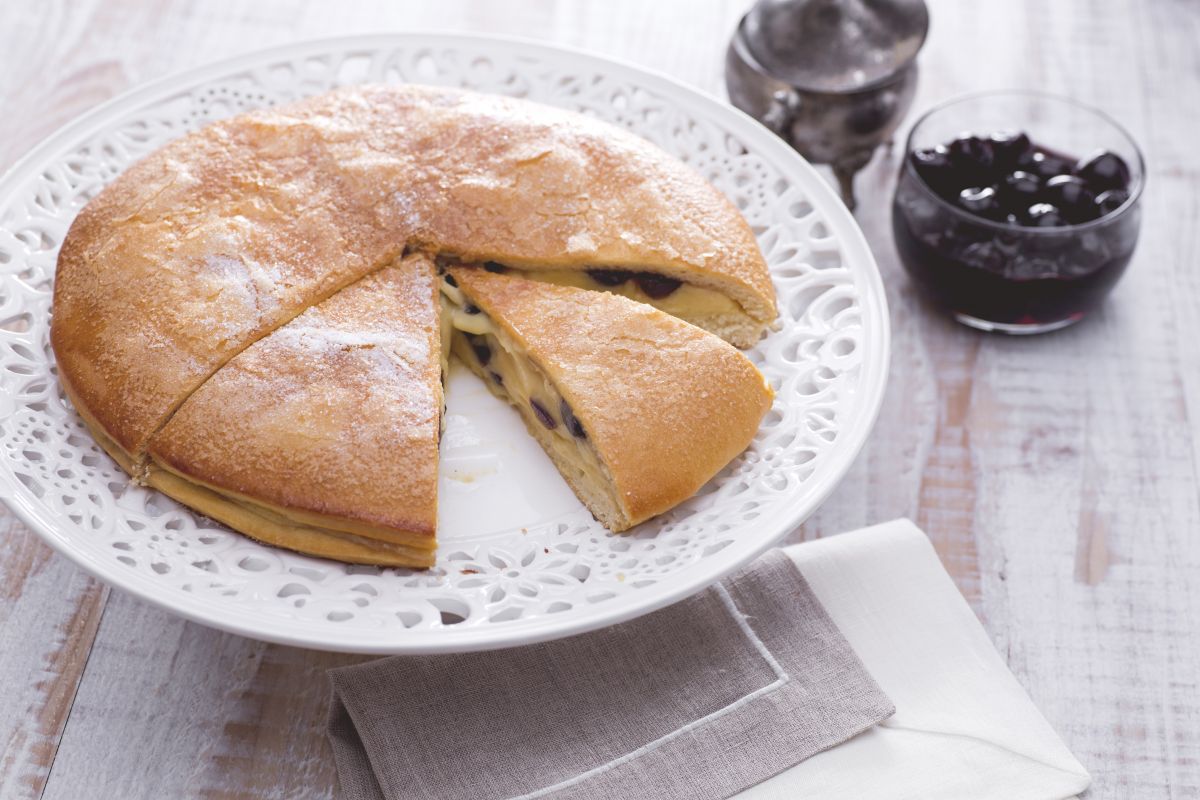Baked Zeppole di San Giuseppe
- Average
- 1 h 50 min
- Kcal 536

So, here's the thing about the polacca aversana—it's more than just a pastry. This tasty treat, straight from Aversa in the Campania region of Italy, is like diving into a piece of its rich culture. Really, it’s quite something. Imagine a delicate, light brioche shell filled with creamy custard and tangy amarene cherries. And look, the locals in Aversa? They love it. Not just for its crispy sugar topping and soft interior, but for the memories it brings back. Esteemed figures like President Giovanni Leone and Pope John Paul II have even praised it, tying this Aversa specialty to the soul of the region.
You'll spot these pastries on the shelves of local shops, perfect with a coffee or, you know, as a treat at family gatherings. What makes this Neapolitan pastry stand out is its balanced blend of flavors. The soft dough with the smooth custard and those zesty cherries—it is seriously good. And the sugar's crunch on top? So so satisfying. Each bite is a tasty experience.
Unlike other local cakes, the polacca aversana uniquely combines these elements, creating a dessert that's not only delicious but also deeply rooted in tradition. It's a go-to during local festivals. Plus, it reflects the warmth and spirit of Campania—simple, genuine ingredients crafted with care. Sharing this dessert? It's more than just a treat. It's a way to connect with the region's history and celebrate its culinary heritage. Whether you are enjoying it with friends or savoring it solo, the polacca aversana is bound to bring a smile—showing the heart and hospitality of Aversa. And really, cannot go wrong with that.

To make the Aversana Polish cake, first prepare the dough: sift the Manitoba flour into a bowl, then add the fresh yeast, crumbling it directly with your hands, add the sugar 1 and mix well. Pour the flour, yeast, and sugar mixture into the bowl of a stand mixer with the hook attachment 2 and start kneading at low speed; while the mixer is running, pour in the room temperature water slowly 3,

then the room temperature milk 4 and the eggs, previously beaten in a small bowl (also at room temperature) 5. Once the eggs have been absorbed, also add the salt 6

and the grated zest of a small lemon (being careful to take only the colored part, less bitter) 7. Finally, add the softened butter little by little, making sure each piece is well absorbed before adding the next 8, and continue working the dough until it adheres to the hook, becoming smooth and elastic 9.

Now transfer the dough onto the work surface and work it by hand 10 just long enough to form a ball; place it in a bowl 11, cover with plastic wrap, and let it rise in the oven turned off with the light on for about 2 hours or until it has doubled in volume. While the dough is rising, you can prepare the filling cream: pour the milk into a fairly large saucepan, add the seeds from the vanilla pod 12, and bring it almost to a boil.

In a separate bowl, beat the egg yolks and sugar with a whisk to combine them 13, then sift the flour into the bowl 14 and beat further to combine. Add a ladle of hot milk to the egg mixture and stir to temper it 15,

then pour the egg mixture into the saucepan with the rest of the milk 16 and bring it to a boil over low heat for about 10 minutes, stirring continuously with a whisk until thickened 17. Once the cream has thickened, transfer it to a baking dish, cover with cling film in contact 18, and let it cool at room temperature for about twenty minutes, then put it in the refrigerator and let it cool completely for about 2 hours.

Meanwhile, drain the cherries from their syrup, cut them in half with a knife 19, and set aside. Once the rising time has elapsed, take the dough and divide it into two equal parts 20; lightly flour the work surface and roll each dough portion 21

until you form a disk 9.5 inches in diameter and 1/5 inch thick 22. Roll one of the two disks onto the rolling pin and transfer it to a baking sheet (there is no need to brush with oil or butter) 23. At this point, you can take the cream from the refrigerator, now cold, and transfer it into a piping bag without a nozzle, then squeeze the cream starting from the center of the first disk and spiraling outward 24.

Use a spatula or the back of a spoon to spread the cream layer evenly, being careful to leave about 3/4 inch from the edge free 25. Distribute the sliced cherries over the cream 26, then gently place the second dough disk over the cream so that it covers the filling well 27.

Take a 9-inch steel ring (alternatively, you can use the removable circle of a cake pan, without the base and the same size), place it over the cream-filled disks and remove the excess dough 28, then with your fingertips, carefully seal the edges of the two dough disks 29. Beat the egg yolk with the milk in a small bowl and brush the cake's surface with the mixture obtained 30,

finally, sprinkle it with granulated sugar 31. Bake the Aversana Polish cake in a preheated static oven at 350°F for about 30 minutes, until the surface is nicely golden 32. Once baked, take the cake out of the oven and let it cool; if desired, you can dust it with powdered sugar. Your delicious Aversana Polish cake is finally ready to be served 33!